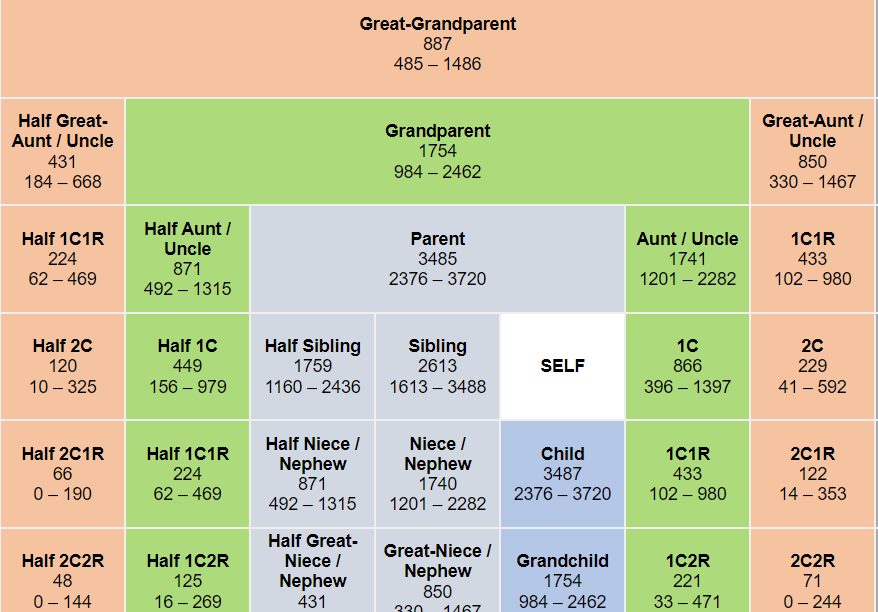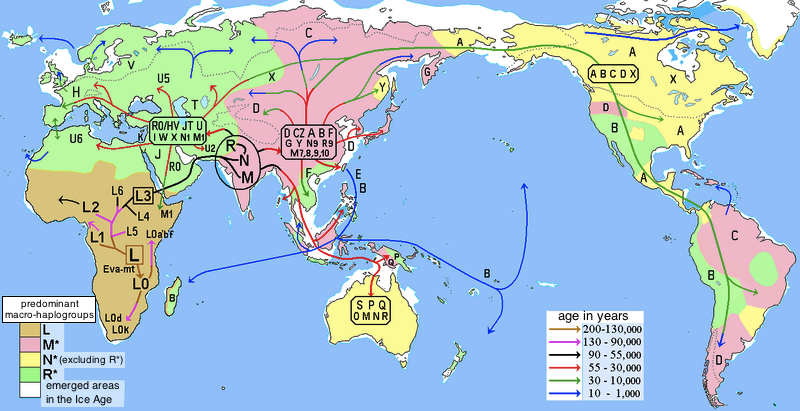The basics of DNA testing for Family History Research

By Kitty Munson Cooper
Blogging at blog.kittycooper.com

My slides are always available at https://slides.com/kittycooper
Why Do A DNA Test?
- Am I who I think I am?
- Where were my ancestors from?
- To find distant cousins who know more
- To find an elusive ancestor


What DNA is Tested?


The test that most companies offer is for your autosomal DNA, your 23 pairs of chromosomes

Three types of DNA tests
An autosomal DNA test looks at the DNA inherited
from ALL your ancestors

Your autosomal DNA test results in about 700,000 lines of data



Your genome contains about 3.1 billion base pairs from each parent
only 700K of which are tested!
98% shared
DNA with him
99.9% with me

How can such a subset be useful?
The companies test the places that most often differ between people, known as SNPs
SNP - Single Nucleotide Polymorphism
a DNA mutation where a single letter chang3s
The tested SNPs were originally chosen for the ones with health implications and for those that could differentiate European ancestries. The companies keep updating the set they use
Can these SNPs really predict where your ancestors were from?
NOT on a country basis for the most part
only by Continent, usually several areas, North, South, East, West ....
- West German looks French
- East German looks Eastern European
- South German can look Italian or East European
- North German can look Scandinavian or English
Two European BioAncestries are clear in the DNA:
Ashkenazi Jewish
Finnish
But the others can overlap greatly
even more than shown in the map
for example German and English
BioAncestry
usually cannot be determined on a country basis
map source: MyHeritage
Remember Kyle in the Ancestry DNA Ad - who discovered he was Scottish not German?

Frankly it is hard to tell them apart as both can look Scandinavian or English...
It turned out his parents had used a Jewish sperm donor

Stan knew he was of 100% German descent!
These were his results at Ancestry
Be prepared for surprises from DNA Testing

Bill was one of the leaders of the Griffeth family History project but by testing his DNA he found that he was not a Griffeth


from Cece Moore's blog at http://www.yourgeneticgenealogist.com/2015/02/switched-at-birth-unravelling-century_27.html
Can those 700K tested SNPs really predict your relationships? Yes for close relationships! But ...


Many relationships have overlapping ranges

Simplified version of the relationship chart from the ISOGG wiki (courtesy Dimario, Wikimedia Commons)

... it is very difficult to tell the difference between a half sibling and a nibling (an aunt/uncle/niece/nephew) relationship from the amount of matching DNA.


You will not match all your 4th cousins or even all your 3rds
but you will match all your 2nd cousins
and closer relatives
What percentage of your cousins will match your DNA?
DNA testing can solve family puzzles ...
by finding cousins with more information

My grandmother Anna Lee
My great-grandma Maren Wold, my brick wall

I looked in every churchbook in Drammen for her with no luck!

He had photos of Maren's parents Jorgen and Anna Wold
Then I heard from a possible 3rd cousin who said, " I think your great grandmother is the sister of my great great grandfather."

Maren was actually from Skoger,now a suburb of Drammen
Part of Skoger is in Vestfold county not the same county as Drammen (Buskerud)


Records from the churchbook for Skoger in Vestfold

ThruLines at Ancestry shows a nice chart of the relationship if you and your cousin both have family trees there linked to DNA tests

Do I really have to look through thousands of matches?


Handling all those cousin matches
NO!
Start with the low hanging fruit, "extended family" about 3rd cousins or closer
(75cM and larger)
Cousin Matches
- How much shared DNA in centimorgans (cM)?
- Who else do they match? (Are they in your tree?)
- How many segments? (More than 2 is best)
- Closer cousins will have larger longest segments (20 cM or more especially if endogamous)

When you contact a possible cousin give them as much information as you can. Offer them photos and stories ...
Getting New Cousins to Respond to You

- Have a family tree online
- Upload friendly picture of yourself
- Include details of who matches whom (they may have multiple kits)
- Offer them information when you write to them
Do not be disheartened by lack of responses, some rarely log in

Three types of personal DNA tests
Y test for father's father's line
mtDNA for mother's mother's line
Autosomal DNA test for all your ancestors
SNP - Single Nucleotide Polymorphism
a DNA mutation where a single letter chang3s
STRs are short tandem repeats
An extra copy is made of a sequence of DNA
An extra copy is made of a sequence of DNA
An extra copy is made of a sequence of DNA
An extra copy is made of a sequence of DNA
An extra copy is made of a sequence of DNA
2 Types of Y DNA Tests
Deep ancestry - haplogroup
More recent ancestry - surname studies

Y Haplogroups

Y Haplogroups
By Chakazul, via Wikimedia Commons [GFDL (http://www.gnu.org/copyleft/fdl.html)

Mitochondria under the microscope

Mitochondrial Haplogroups

Mitochondrial Haplogroups


Why Do A DNA Test?
- Am I who I think I am?
- Where were my ancestors from?
- To find distant cousins who know more
- To find an elusive ancestor, solve a mystery


Where to test? It depends ...
- 23andme.com*
- Ancestry.com*
- MyHeritage

The Big Three:
- FamilyTreeDNA.com
- LivingDNA
- health results, chromosome browsers
- biggest database, tree matching
- more Europeans, trees and records
- keeps sample, Y and mtDNA, chromosome browsers
- has granular admix results for the British Isles
* These companies do not take uploads of tests from elsewhere

DNA Testing Basics for Genealogists
By Kitty Cooper
DNA Testing Basics for Genealogists
How personal genome tests can help a genealogist
- 2,408



